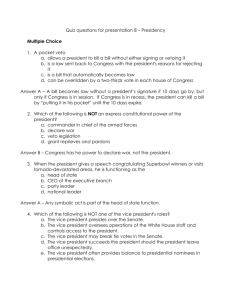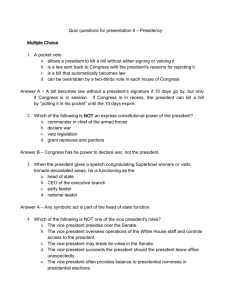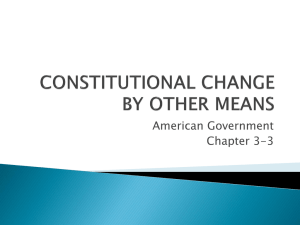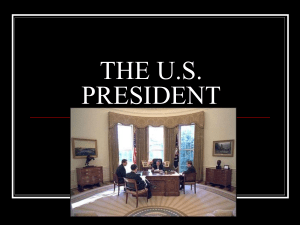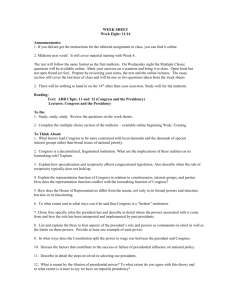AP Government Chapter 13 Notes: The Presidency
advertisement
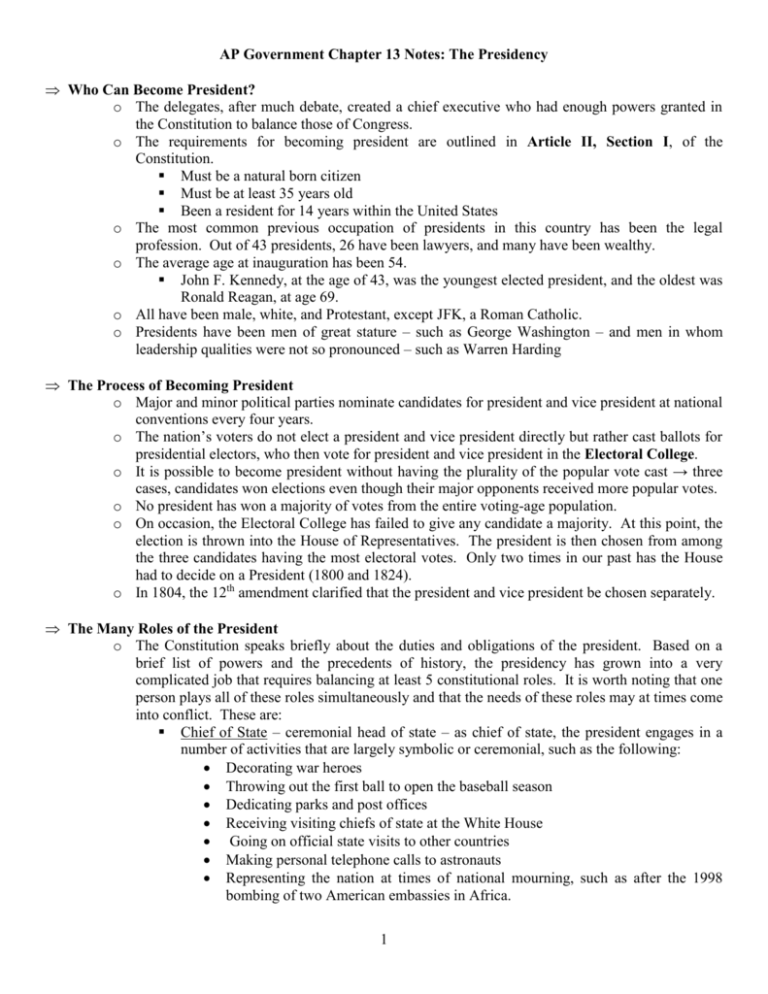
AP Government Chapter 13 Notes: The Presidency Who Can Become President? o The delegates, after much debate, created a chief executive who had enough powers granted in the Constitution to balance those of Congress. o The requirements for becoming president are outlined in Article II, Section I, of the Constitution. Must be a natural born citizen Must be at least 35 years old Been a resident for 14 years within the United States o The most common previous occupation of presidents in this country has been the legal profession. Out of 43 presidents, 26 have been lawyers, and many have been wealthy. o The average age at inauguration has been 54. John F. Kennedy, at the age of 43, was the youngest elected president, and the oldest was Ronald Reagan, at age 69. o All have been male, white, and Protestant, except JFK, a Roman Catholic. o Presidents have been men of great stature – such as George Washington – and men in whom leadership qualities were not so pronounced – such as Warren Harding The Process of Becoming President o Major and minor political parties nominate candidates for president and vice president at national conventions every four years. o The nation’s voters do not elect a president and vice president directly but rather cast ballots for presidential electors, who then vote for president and vice president in the Electoral College. o It is possible to become president without having the plurality of the popular vote cast → three cases, candidates won elections even though their major opponents received more popular votes. o No president has won a majority of votes from the entire voting-age population. o On occasion, the Electoral College has failed to give any candidate a majority. At this point, the election is thrown into the House of Representatives. The president is then chosen from among the three candidates having the most electoral votes. Only two times in our past has the House had to decide on a President (1800 and 1824). o In 1804, the 12th amendment clarified that the president and vice president be chosen separately. The Many Roles of the President o The Constitution speaks briefly about the duties and obligations of the president. Based on a brief list of powers and the precedents of history, the presidency has grown into a very complicated job that requires balancing at least 5 constitutional roles. It is worth noting that one person plays all of these roles simultaneously and that the needs of these roles may at times come into conflict. These are: Chief of State – ceremonial head of state – as chief of state, the president engages in a number of activities that are largely symbolic or ceremonial, such as the following: Decorating war heroes Throwing out the first ball to open the baseball season Dedicating parks and post offices Receiving visiting chiefs of state at the White House Going on official state visits to other countries Making personal telephone calls to astronauts Representing the nation at times of national mourning, such as after the 1998 bombing of two American embassies in Africa. 1 o Being chief of state gives the president tremendous public exposure, which can be an important asset in a campaign for reelection. o When that exposure is positive, it helps the president deal with Congress over proposed legislation and increases the chances of being reelected – or getting the candidates of the president’s party elected. Chief Executive – the president is constitutionally bound to enforce the acts of Congress, the judgments of federal courts, and treaties signed by the United States. To assist in the various tasks of the chief executive, the president has a federal bureaucracy, which currently consists of about 2.8 million federal civilian employees. The Powers of Appointment and Removal o The president only nominally runs the executive bureaucracy, for most government positions are filled by civil service employees. o Even though the president has appointment power, it is not very extensive, being limited to cabinet and sub-cabinet jobs, federal judgeships, agency heads, and about 2000 lesser jobs. o This means that most of the 2.8 million federal employees owe no political allegiance to the president. They are more likely to owe loyalty to congressional committees or to interest groups representing the sector of society that they serve. o The president’s power to remove from office officials who are not doing a good job or who do not agree with the president is not explicitly granted by the Constitution and has been limited. There are 10 agencies whose directors the president can remove at any time. These agencies include: The Arms Control and Disarmament Agency The Commission on Civil Rights The Environmental Protection Agency The General Services Administration The Postal Service The Small Business Administration All heads of cabinet departments All individuals in the Executive Office of the President All political appointees The Power to Grant Reprieves and Pardons – Section 2 of Article II of the Constitution gives the president the power to grant reprieves and pardons for offenses against the United States except in cases of impeachment. o All pardons are administered by the Office of the Pardon Attorney in the Department of Justice. In principle, pardons are granted to remedy a mistake made in a conviction. o The Supreme Court upheld the president’s power to grant reprieves and pardons in a 1925 case concerning the pardon granted by the president to an individual convicted of contempt of court. The judiciary contended that only judges had the authority to convict individuals for contempt of court when the court orders were violated and that the courts should be free from interference by the executive branch. The Supreme Court simply stated that the president could grant reprieves or pardons for all offenses “either before trial, during trial, or after trial, by individuals, or by classes, conditionally or 2 absolutely, and this without modification or regulation by Congress.” Commander in Chief – according to the constitution, the president is the commander in chief of the Army and Navy. In other words, the armed forces are under civilian, rather than military, control. The president is the ultimate decision maker in military matters. Only the president has the power to order the use of nuclear force. Constitutionally, Congress has the sole power to declare war, but the president can send the armed forces into a country in situations that are certainly equivalent of war. In an attempt to gain more control over such military activities, in 1973 Congress passed the War Powers Resolution – over President Nixon’s veto – requiring that the president consult with Congress when sending American forces into action. o Once they are sent, the president must report to Congress within 48 hours. Unless Congress approves the use of troops within 60 days or extends the 60 day time limit, the forces must be withdrawn. o In spite of the War Powers Resolution, the powers of the president as commander in chief are more extensive today than they were in the past. o These powers are linked closely to the president’s powers as chief diplomat, or chief crafter of foreign policy. Chief Diplomat – the constitution gives the president the power to recognize foreign governments; to make treaties, with the advice and consent of the Senate; and to make special agreements with other heads of state that do not require congressional approval. In addition, the president nominates ambassadors. As chief diplomat, the president dominates American foreign policy, a role that has been supported numerous times by the Supreme Court. Diplomatic Recognition or the power to recognize – or refuse to recognize – foreign governments. o In the role of ceremonial head of state, the president has always received foreign diplomats. In modern times the simple act of receiving a foreign diplomat has been equivalent to accrediting the diplomat and officially recognizing his or her government. o Such recognition of the legitimacy of another country’s government is a prerequisite to diplomatic relations or negotiations between that country and the United States. o Deciding when to recognize a foreign power is not always simple. Proposal and Ratification of Treaties – the president has the sole power to negotiate treaties with other nations. These treaties must be presented to the Senate, where they may be modified and must be approved by a 2/3 vote. After ratification, the President can approve the senatorial version of the treaty. o The president may decide to withdraw a treaty if senatorial changes are too extensive. Executive Agreements – presidential power in foreign affairs is enhanced greatly by the use of executive agreements made between the president and other heads of states. o Such agreements do not require Senate approval, although the House and Senate may refuse to appropriate the funds necessary to implement them. o Whereas treaties are binding on all succeeding administrations, executive agreements are not binding without each new president’s consent. 3 o Among the advantages of executive agreements are speed and secrecy. The former is essential during a crisis; the latter is important when the administration fears that open senatorial debate may be detrimental to the best interests of the United States or the interests of the president. o There have been far more executive agreements (about 9000) than treaties (about 1300). o Many executive agreements contain secret provisions calling for American military assistance or other support Chief Legislator -- Constitutionally, presidents must recommend to Congress legislation that they judge necessary and expedient. In modern times, the president has played a dominant role in creating the congressional agenda → State of the Union Message which is required by the Constitution (Article II, Section 3) and is usually given in late January shortly after Congress reconvenes, the president as chief legislator presents his program. The message gives a broad, comprehensive view of what the president wishes the legislature to accomplish during its session. It is as much a message to the American people and to the world as it is to Congress. Its impact on public opinion can determine the way in which Congress responds to the president’s agenda. Getting Legislation Passed - the president can propose legislation, but Congress is not required to pass any of the administration’s bills. How, then does the president get those proposals made into law? o One way is by exercising the power of persuasion -- the president writes to, telephones, and meets with various congressional leaders; makes public announcements to force the weight of public opinion onto Congress in favor of a legislative program; and as head of the party, exercises legislative leadership through the congresspersons of the president’s party Saying No to Legislation – the president has the power to say no to legislation through the use of the veto, by which the White House returns a bill unsigned to Congress with a veto message attached. o Because the Constitution requires that every bill passed by the House and the Senate be sent to the president before it becomes law, the president must act on each bill: If the bill is signed, it becomes law If the bill is not sent back to Congress after 10 congressional working days, it becomes law without the president’s signature The president can reject the bill and send it back to Congress with a veto message setting forth objections. Congress then can change the bill, hoping to secure presidential approval and re-pass it. Or it can simply reject the president’s objections by overriding the veto with a 2/3 roll-call vote of the members present in each house. If the president refuses to sign the bill and Congress adjourns within 10 working days after the bill has been submitted to the president, the bill is killed for that session of Congress. If Congress wishes the bill to be reconsidered, the bill must be reintroduced during the following session. This is called a pocket veto. Line-Item Veto – Reagan lobbied for Congress to give another tool to the president – the line-item veto. In 1996, Congress passed a law providing for the 4 line-item veto (the power to veto individual lines or items within a piece of legislation without vetoing the entire bill). o The act was challenged in Court as an unconstitutional delegation of legislative powers to the executive branch. o In 1998, the Supreme Court agreed and overturned the act. The Court stated that “there is no provision in the Constitution that authorizes the president to enact, to amend or to repeal statutes.” Congress’s Power to Override Presidential Vetoes – a veto is a clear-cut indication of the president’s dissatisfaction with congressional legislation. Congress can override a presidential veto – 2/3 of the members of both houses who are present can vote to override the president’s veto in a roll-call vote. Measuring the Success or Failure of a President’s Legislative Program – one way of determining a president’s strength is to evaluate that president’s success as chief legislator. A strong president may be one who has achieved much of the administration’s legislative program; a weak president has achieved little. o Other Presidential Powers The powers of the president above are called constitutional powers, because their basis lies in the Constitution. Congress has established by law, or statute, numerous other presidential powers – such as the ability to declare national emergencies. These are called statutory powers. Both constitutional and statutory powers have been labeled the expressed powers of the president, because they are expressly written in the Constitution or into law. Presidents also have what have come to be known as inherent powers. These depend on the loosely worded statement in the Constitution that “the executive power shall be vested in a president” and that the president should “take care that the laws be faithfully executed.” The most common example of inherent powers are those emergency powers invoked by the president during wartime. The President as Party Chief and Superpolitician o The President as Chief of Party -- As a party leader, the president chooses the national committee chairperson and can try to discipline party members who fail to support presidential policies. One way of exerting political power within the party is by patronage – appointing individuals to government or public jobs. The most important role that the president played for his party in the late 1990s and early 2000 was that of fund-raiser. Because of the ability of political parties to accept unregulated contributions in the form of “soft money”, the president is able to raise large amounts of money for the political party through appearances at dinners, speaking engagements, and other social occasions. The president may make it known that a particular congressperson’s choice for federal judge will not be appointed unless that member of Congress is more supportive of the president’s legislative program. The president may agree to campaign for a particular program or for a particular candidate. Presidents also reward loyal supporters in congress with funding for local projects, tax breaks for regional industries, and other forms of “pork.” o Constituencies and Public Approval -- Presidents have many constituencies. In principle, they are beholden to the entire electorate – the public of the United States – even to those who did not vote. They are beholden to their party constituencies because its members put them in office. 5 The president’s constituencies also include members of the opposing party whose cooperation the president needs. The president has to take into consideration a constituency that has come to be called the Washington Community. This community consists of individuals who – whether in or out of political office – are intimately familiar with the workings of government, thrive, gossip, and measure on a daily basis the political power of the president. The presidential preoccupation with public opinion has been criticized by at least one scholar as changing the balance of national politics. Since the early 20th century, presidents have spoken more to the public and less to congress. In the 19th century, on 7% of presidential speeches were addressed to the public Since 1900, 50% have been addressed to the public. Samuel Kernell has proposed that the style of presidential leadership has changed since WWII, owing partly to the influence of television. Presidents frequently go over the heads of Congress and the political elites, taking their cases directly to the people. This strategy, which Kernell dubbed “going public,” gives the president additional power through the ability to persuade and manipulate public opinion. Special Uses of Presidential Power o Presidents have at their disposal a variety of special powers and privileges not available in other branches of the U.S. government. Emergency Powers – an inherent power exercised by the president during a period of national crisis, particularly in foreign affairs. The Supreme Court has indicated that an “emergency does not create power.” Executive Orders – a rule or regulation issued by the president that has the effect of law. These executive orders can do the following: Enforce legislative statutes Enforce the Constitution or treaties with foreign nations Establish or modify rules and practices of executive administrative agencies o An executive order represents the president’s legislative power. The only requirement is that under the Administrative Procedure Act of 1946, all executive orders must be published in the Federal Register, a daily publication of the U.S. government. o Executive orders have been used to establish some procedures for appointing non-career administrators, to implement national affirmative action regulations, to restructure the White House bureaucracy, to ration consumer goods and to administer wage and price controls under emergency conditions, to classify government information as secret, and to regulate the export of restricted items. Executive Privilege – another inherent executive power that has been claimed by presidents concerns the ability of the president and the president’s executive officials to refuse to appear before, or to withhold information from, Congress, or the courts. It relies on the constitutional separation of powers for its basis. Critics of executive privilege believe that it can be used to shield from public scrutiny actions of the executive branch that should be open to Congress and to the American public. Limits to executive privilege went untested until the Watergate affair in the early 1970s. 6 o United States v. Nixon (1974) – the Supreme Court unanimously ruled that Nixon could not claim executive privilege in handing over the tapes. The Court held that executive privilege could not be used to prevent evidence from being heard in criminal proceedings. Impoundment of Funds – by law, the president proposes a budget, and Congress approves it. But there is no provision in the Constitution that requires the president, as chief executive, to spend all of the funds appropriated by Congress, and many presidents prior to the 1070s did not do so. The question of whether a president is required to spend all appropriated funds came to a head during Nixon’s presidency. He vetoed appropriation bills, Congress often overrode his veto. In retaliation, Nixon refused to spend the appropriated funds, claiming he wanted to reduce overall federal spending. The Supreme Court in 1975 unanimously ruled that the president had to spend money appropriated by Congress because of his constitutional obligation to “take care that the laws be faithfully executed.” Abuses of Executive Power and Impeachment o Articles I and II of the Constitution authorize the House and the Senate to remove the president, the vice president, or other civil officers of the United States for crimes of “treason, bribery, or other high crimes and misdemeanors.” Impeachment process begins in the House, which impeaches (accuses) the federal officer involved. If the House votes to impeach the officer, it draws up articles of impeachment and submits to the Senate, which conducts the actual trial. If a president is impeached, the Supreme Court Chief Justice hears the case. In the history of the U.S. no president has been impeached and also convicted. President Andrew Johnson, who became president after the assassination of Abraham Lincoln, was seen as too lenient to the southern states after the Civil War by the Radical Republicans. He was impeached by the House, but not convicted by the Senate President Richard Nixon was going to be impeached, but before the House could vote to impeach, he resigned. Bill Clinton was the second president to be impeached, but was not convicted by the Senate. The Executive Organization o It was not until 1857 that Congress authorized a private secretary for the president, to be paid by the federal government o At the beginning of Franklin Roosevelt’s long tenure in the White House, the entire staff consisted of 37 employees. It was not until the New Deal and WWII that the presidential staff became a sizeable organization. o Today, the executive organization includes a White House Office staff of about 600. o The more than 350 employees who work in the White House Office itself are closest to the president. They often include many individuals who worked in the president’s campaign. These assistants are most concerned with preserving the president’s reputation. o The Cabinet – Although the Constitution does not include the word cabinet, it does state that the president “may require the opinion, in writing, of the principal officer in each of the executive departments.” Originally the cabinet consisted of only four officials – the secretaries of state, treasury, and war, and the attorney general (see p. 454, 456, 457). 7 Because neither the Constitution nor statutory law requires the president to consult with the cabinet, its use is purely discretionary. Some presidents have relied on the counsel of their cabinets more than others. In general, few presidents have relied heavily on the advice of their cabinet members. Often, a president will use a kitchen cabinet to replace the formal cabinet as a major source of advice. A kitchen cabinet is a very informal group of advisors, who usually are friends of the president with whom the president worked before being elected. Often, the departmental heads are more responsive to the wishes of their own staffs or to their own political ambitions than they are to the president. There is often a strong conflict of interest between presidents and their cabinet members. It is likely that formal cabinet meetings are held more out of respect for the cabinet tradition than for their problem-solving value. o The Executive Office of the President – When President Franklin Roosevelt appointed a special committee on administrative management, he knew that the committee would conclude that the president needed help. Congress created the Executive Office of the President (EOP) to provide staff assistance for the chief executive and to help coordinate the executive bureaucracy. Several of the offices within the EOP are especially important, including the White House Office, the Council of Economic Advisors, the Office of Management and Budget, and the National Security Council. These agencies are as follows: White House Office (1939) One of the most important of the agencies within the EOP, which includes most of the key personal and political advisors to the president. Among the jobs held by these aides are those of legal counsel to the president, secretary, press secretary, and appointments secretary. Often, the individuals who hold these positions are recruited from the president’s campaign staff. The Chief of Staff is responsible for coordinating the office, is one of the president’s chief advisors. The appointments secretary is able to grant or deny senators, representatives, and cabinet secretaries access to the president. The press secretary grants to the press and television journalists access to any information about the president. Council of Economic Advisors (1946) The Employment Act of 1946 created a three-member Council of Economic Advisors (CEA) to advise the president on economic matters. The council’s advice serves as the basis for the president’s annual economic report to Congress. Each of the three members is appointed by the president and can be removed at will. In principle, the CEA was also created to advise the president on economic policy, but for the most part the function of the CEA has been to prepare the annual report. National Security Council (NSC) (1947) The NSC is a link between the president’s key foreign and military advisers and the president. Its members consist of the president, vice president, and the secretaries of state and defense, plus other informal members. The NSC has the resources of the National Security Agency (NSA) at its disposal in giving counsel to the president. 8 The NSA protects U.S. government communications and produces foreign intelligence information. Included in the NSC is the president’s special assistant for national security affairs. Office of the United States Trade Representative (1963) Council on Environment Quality (1969) Office of Management and Budget (OMB) (1970) Was originally the Bureau of the Budget, which was created in 1921 within the Department of the Treasury. It is headed by a director, who must make up the annual federal budget that the president presents to Congress each January for approval. In principle, the director of the OMB has broad fiscal powers in planning and estimating various parts of the federal budget, because all agencies must submit their proposed budget to the OMB for approval. Office of Science and Technology Policy (1976) Office of Administration (1977) Office of National Drug Control Policy (1988) Office of Policy Development (1993) The Vice Presidency o The Constitution does not give much power to the vice president. The only former duty is to preside over the Senate – which is rarely necessary. o The Vice President’s Job Vice presidents have traditionally been chosen by presidential nominees to balance the ticket to attract groups of voters or appease party factions. In recent presidential elections, vice presidents have been selected for other reasons. Vice presidents infrequently have become elected presidents in their own right. The job of the vice president is not extremely demanding, even when the president gives some specific task to the vice president. Typically, vice presidents spend their time supporting the president’s activities. o Presidential Succession Eight vice presidents have become president because of the death of the president. What should a vice president do if a president becomes incapable of carrying out necessary duties while in office? This question was not addressed in the original Constitution. Article II Section I says that only that “in case of the removal of the President from office, or of his death, resignation, or inability to discharge the powers and duties of the said office, the same shall devolve on the Vice President.” There have been many instances of presidential disability. In 1967, the 25th amendment was passed, establishing procedures in case of presidential incapacity. o The Twenty-Fifth Amendment – when the president believes that he is incapable of performing the duties of office, he must inform Congress in writing. Then, the vice president serves as acting president until the president can resume his normal duties. When the president is unable to communicate, a majority of the cabinet, including the vice president, can declare that fact to Congress. Then the vice president serves as acting president until the president resumes his normal duties. 9 If a dispute arises over the return of the president’s ability to discharge his normal functions, a 2/3 vote of Congress is required to decide whether the vice president shall remain acting president or whether the president shall resume his duties. o When the Vice Presidency Becomes Vacant – the 25th amendment also addresses the issue of how the president should fill a vacant vice presidency. Section 2 of the amendment simply states, “whenever there is a vacancy in the office of the Vice President, the President shall nominate a Vice President who shall take office upon confirmation by a majority vote of both houses of Congress.” This occurred in 1973 when Nixon’s vice president Spiro Agnew resigned. Nixon nominated Gerald Ford to replace him. In 1974, when Nixon resigned, Ford became president and Ford nominated Nelson Rockefeller as vice president. For the first time in the history of the country, both the president and the vice president were individuals who were not elected to their positions. The question of who shall be president if both the president and vice president die is answered by the Succession Act of 1947. If the president and vice president die, resign, or are disabled, the speaker of the House will act as president, after resigning from Congress. Line of Succession is as follows: Vice president Speaker of the House Senate president pro tempore Secretary of State Secretary of the Treasury Secretary of defense Attorney General Secretary of the interior Secretary of agriculture Secretary of commerce Secretary of labor Secretary of health and human services Secretary of housing and urban development Secretary of transportation Secretary of energy Secretary of education Secretary of veterans affair 10




